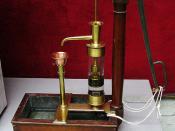Pompe disease is a rare neuromuscular genetic disorder that can happen in infants, children, and adults that acquire a faulty gene from their parents. The most common symptom of Pompe is progressive muscle weakness. The muscle weakness is due to the build up of glycogen in the lysosomes. The glycogen continues to build and takes up so much space that the muscle becomes damaged. Eventually the glycogen seeps out of the lysosome causing more damage to the other cells. This causes a person to have sever muscle weakness that worsens over time. The disease is caused by a defect in the gene that is responsible for making the enzyme called acid alpha-glucosidase (GAA). GAA is suppose to break down glycogen in the lysosomes. In people suffering from Pompe, there is a lack of the GAA enzyme or it is completely missing, causing the glycogen to build up.
This disease is best treated by a team of specialists that have the proper knowledge and care for the patients.
The discovery of the GAA gene has led to a growing progress in understanding the biological mechanisms and the GAA enzyme. According to the National Institute of Neurological Disorders and Stroke, ÃÂan enzyme replacement therapy has been developed that has shown, in clinical trials, to decrease heart size, maintain normal heart function, improve muscle function, tone, and strength, and reduce glycogen accumulation.ÃÂ There is also a drug called aglucosidase alfa that has been approved by the FDA to treat the disease.
In an article from Science Magazine, in 1996, a Dutch biotechnology firm planned to invest in a facility for milking rabbits. ÃÂThe company, called Pharming, has created a line of transgenic rabbits that secrete into their milk a potential drug for a rare human genetic disorder called Pompe's disease. It had been suggested that giving patients a form of the GAA enzyme would help prevent muscle deterioration. Due to low supplies of GAA, the theory could only be tested in cell cultures. Pharming decided to splice the GAA gene into the rabbit genome. The female rabbits can produce about one gram of the enzyme per liter of milk. The milking facility in Belgium should be ready sometime in 1998.
Works Cited"M"Learning About Pompe." Pompe Community. 2008. 2 Oct. 2008 .
ÃÂMilking Bunnies." Science Magazine. 6 Dec. 1996. 2 Oct. 2008 "Pompe Disease Information Page." National Institute of Neurological Disorders and Stroke. 25 July 2007. 2 Oct. 2008 .



